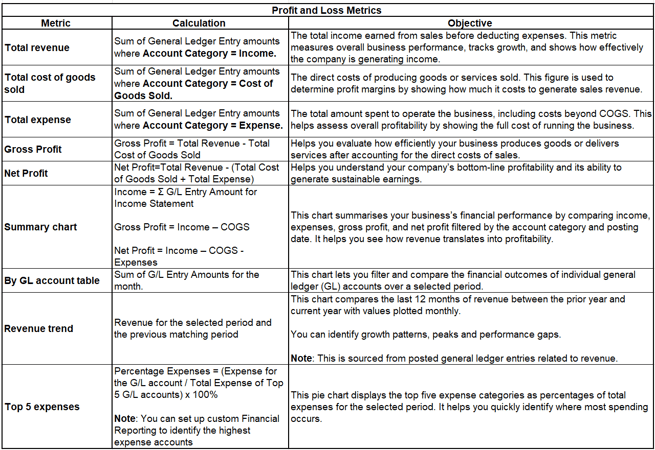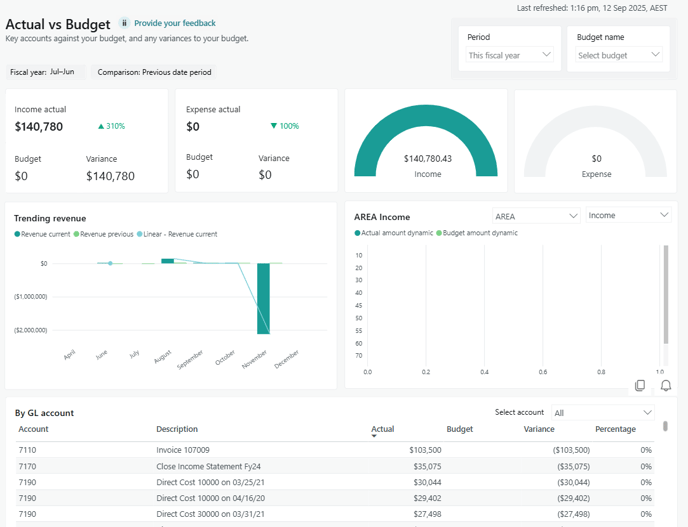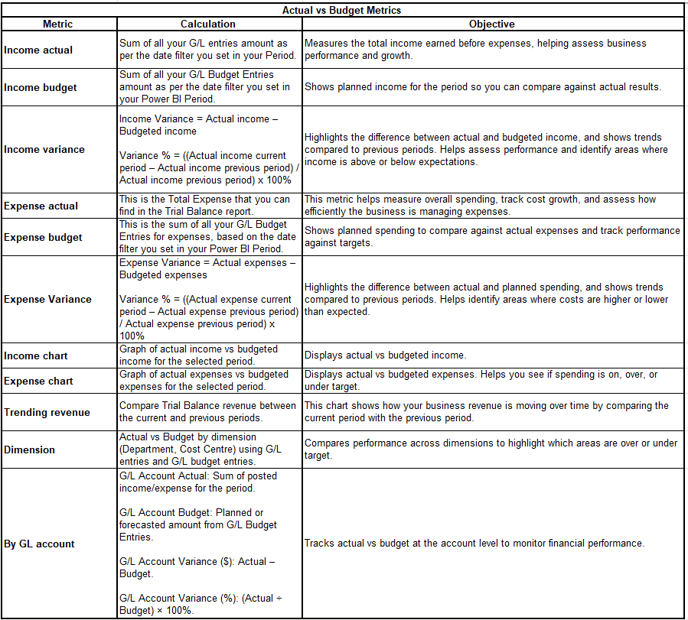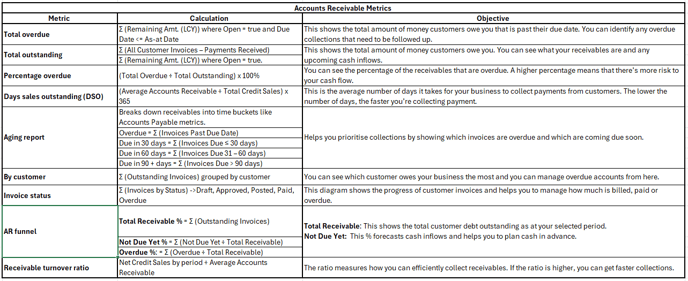Use Wiise Financial Dashboards in Power BI
Overview:
- Profit and Loss report
- Actual vs Budget report
- Accounts Payable report
- Accounts Receivable report
- Cashflow Insights report
Why Use Wiise Financial Dashboards in Power BI?
Wiise Financial Dashboards in Power BI give you real-time visibility into your business’s financial performance through key metrics. These metrics help you make efficient, informed decisions by consolidating financial data into interactive reports and visual insights.
Before you Begin:
- Make sure that Wiise Dashboards are installed and connected to Power BI.
- When you access the Profit and Loss or Actual vs Budget reports, you can select various date ranges. Select the Period drop-down to select the date range for your Profit and Loss or Actual vs Budget report:
- This week: From the first day of the week to today.
- This month: From the first day of the current month to today.
- This quarter: From the first day of the quarter to today.
- This fiscal year: As set up in Wiise (default: 1 July to 30 June).
- This calendar year: From 1 January to today.
- Budget name: When you’ve created a budget in Wiise, you can select the budget to compare against actuals. Select the Budget name drop-down to apply a budget on your Profit and Loss or Actual vs Budget reports.
Tip: To navigate any dashboard, you can hover for tooltips and drill through details.
How to Use Wiise Financial Dashboards in Power BI?
1. Profit and Loss
- Select the Profit and Loss menu. The Profit and Loss Power BI reports display.

- Here’s how to read and understand the tiles on the Profit and Loss report metrics:

- You now know how to use the Profit and Loss report in Power BI.
2. Actual vs Budget
- Select the Actual vs Budget menu. The Actual vs Budget Power BI reports display.

- Here’s how to read and understand the tiles on the Actual vs Budget report metrics:

- You now know how to use the Actual vs Budget report in Power BI.
Note: The variance percentage rate is shown in red or green to indicate change compared to the previous period. Green indicates a favourable change, while red indicates an unfavourable change.
3. Accounts Payable
- Select the Accounts Payable menu. The Accounts Payable Power BI reports display.

- Here’s how to read and understand the tiles on the Accounts Payable report metrics:

- You now know how to use the Accounts Payable report in Power BI.
4. Accounts Receivable
- Select the Accounts Receivable menu. The Accounts Receivable Power BI reports display.

- Here’s how to read and understand the tiles on the Accounts Receivable report metrics:

- You now know how to use the Accounts Receivable report in Power BI.
5. Cashflow Insights
Use this dashboard to monitor liquidity, assess financial health, and plan for upcoming cash needs.
- Select the Cashflow Insights menu. The Cashflow Insights Power BI reports display.

Note: You can view insights for the next 7, 30, 60, 90 or 120 days for the four metrics on the top panel which are:
- Cash in hand today
- Cash going in
- Cash going out
- Ending cash in hand
Note: Cashflow Insights is designed to report actual cash movement. This means the Cash going in and Cash going out tiles do not use applied entries when calculating inflows and outflows, as applied entries do not change the bank balance.
Note: The other metrics on the dashboard which are Previous cashflow, Projected cashflow, Expenses, and AR turnover vs AP turnover, are based on results covering the past six months, and reflect historical patterns or averages over that period.
- Here’s how to read and understand the tiles on the Cashflow Insights report metrics:
Cashflow Insights Metrics
Metric
Calculation
Objective
Cash in hand today
Cash balance in bank account - Current Liabilities
Shows how much cash is available right now across all bank and cash accounts so you can see your true liquidity at a glance.
Cash going in
Sum of Remaining Amount (LCY) on open Customer Ledger Entries with Due Date in the selected period.
Estimates future cash inflows from customers over the selected period so you can see how much cash is expected to arrive.
Cash going out
Sum of Remaining Amount (LCY) × –1 on open Vendor Ledger Entries with Due Date in the selected period
Shows total outgoing cash for the selected period such as vendor payments, salaries, rent, and other expenses.
Ending cash in hand
Cash in hand today + Cash going in − Cash going out
Shows your closing cash position at the end of the selected period
Previous cashflow
From Bank Account Ledger Entries
Cash In = Sum of Debit Amount
Cash Out = Sum of Credit Amount (negative)Grouped by month for the last 6 full months (plus current month to date).
Shows actual historical cash movement each month so you can compare past inflows and outflows and spot trends in cash usage.
Projected cashflow
Based on open Customer and Vendor Ledger Entries for the next six months (including the current month):
Projected Cash In = Sum of Customer Remaining Amount (LCY)
Projected Cash Out = Sum of Vendor Remaining Amount (LCY) x –1
Amounts are grouped by month using the Due Date (current month starts from tomorrow to month-end, then full months after).
Provides a month-by-month forward view of expected cash in and out so you can plan for upcoming surpluses or gaps.
Expenses
From G/L Accounts where:
Type = Posting
Income/Balance = Income Statement
Account Category = ExpenseThen from General Ledger Entries for those accounts:
Sum of Amount per month over the last 6 months (including current month).
Shows actual monthly expenses by major cost type, helping you understand where cash is being spent and control operating costs.
AR turnover vs AP turnover
Measured over the last 6 months, plotted by month.
AR Turnover
Total Credit Sales / Average Accounts Receivable
Total Credit Sales = Sum Cust. Ledger Entry.Amount (Posting Date in month, Payment Method ≠ CASH)
Average AR = (Opening AR + Closing AR) / 2, based on Remaining Amount on open customer entries.
AP Turnover
Total COGS / Average Accounts Payable
Total COGS = Sum G/L Entry.Amount for COGS accounts in the month
Average AP = (Opening AP + Closing AP) / 2, using Remaining Amount × –1 on vendor entries.
Compares how quickly you collect from customers (AR) versus how quickly you pay suppliers (AP), helping you assess the health of your working capital and payment practices.
- You now know how to use the Cashflow Insights report in Power BI.
Note: Each Wiise Power BI dashboard includes a Provide your Feedback link. When you select it, a new tab opens where you can easily share your thoughts on the dashboard.
What’s next?
Find out how to refresh your Power BI dashboards.
Need more help?
No problem, that's what we're here for. Reach out to support@wiise.com anytime you can't find what you're looking for.